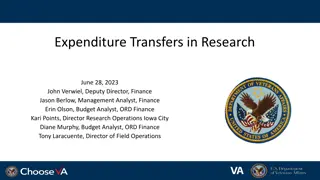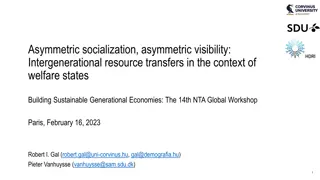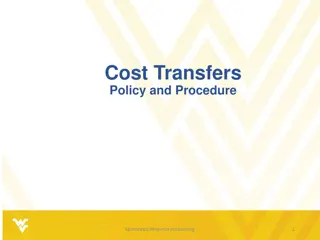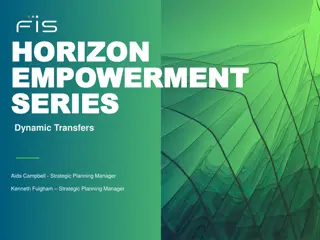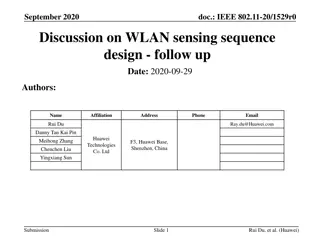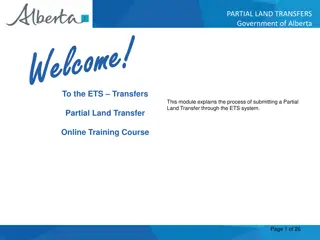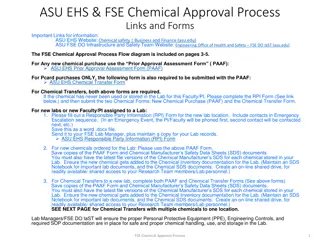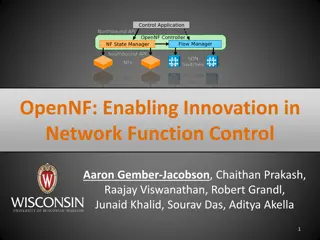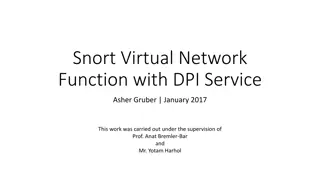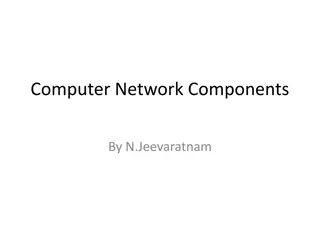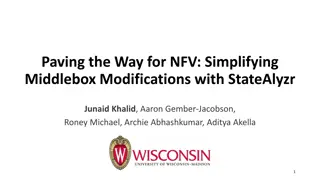Enhancing Network Function State Transfers
Explore methods to improve the safety, scalability, and efficiency of network function state transfers. Addressing issues related to NF deployments, state management frameworks, and transfer mechanisms. Discuss challenges like safety, efficiency, and scalability with solutions such as re-routing flows, managing NF state, and enhancing output delay during state transfers.
Download Presentation

Please find below an Image/Link to download the presentation.
The content on the website is provided AS IS for your information and personal use only. It may not be sold, licensed, or shared on other websites without obtaining consent from the author. Download presentation by click this link. If you encounter any issues during the download, it is possible that the publisher has removed the file from their server.
E N D
Presentation Transcript
Improving the Safety, Scalability, and Efficiency of Network Function State Transfers Aaron Gember-Jacobson & Aditya Akella 1
Dynamic NF deployments NFV: start instances on-demand SDN: re-route flows on-demand Hypervisor NF that is v2 v2 Auto-scaled Immediately updated Opportunistically augmented 2
What about NF state? E.g., endpoint metadata, packet payloads, counters Possible solutions Only re-route new flows Clone virtual machines NF state management frameworks E.g., Split/Merge [NSDI 13], OpenNF [SIGCOMM 14] 3
State transfers in OpenNF Control App move(red, IDS1 IDS2) OpenNF Controller redirectPkts(red) forward (red,IDS2) putState( ) getState(red) IDS1 IDS2 4
Problems 2) Safety 1) Efficiency buffering output delayed Control App overflow loss move(red, Bro1, Bro2) incomplete analysis OpenNF Controller OpenNF Controller redirectPkts(red) forward (red,Bro2) putState( ) getState(red) 3) Scalability transfer via controller IDS1 IDS2 5
This talk 2) Safety 1) Efficiency buffering output delayed 1) Efficiency buffering output delayed these issues? How do we solve overflow loss incomplete analysis 3) Scalability transfer via controller 6
Output delay No packet processing (+ output) during state transfer Live virtual machine migration State is small memory page is too coarse A B C D E F G H I J K L J K L 4 5 6 4 5 6 4 5 6 A B C D E F G H I 7 8 9 7 8 9 1 2 3 1 2 3 1 2 3 1 2 3 4 5 6 7
Packet reprocessing Process packet again again; no output Process packet P1 P2 move(red, NF1 NF2) Recopy? S2 S1 S1 S2 P1 P2 P2 NF2 NF1 Process packet Controller How do we suppress output? wrappers for network and file I/O functions 8
Benefits of reprocessing (1) Buffering does not impact output latency 25 Avg pkt latency (ms) 20 Normal pkts 15 4x lower latency Redirected pkts (original OpenNF) 10 5 Reprocessed pkts (new design) 0 4 12 20 28 36 44 52 Traffic rate (1000s of pkts/sec) 9
Benefits of reprocessing (2) We can safely recover from buffer overflow P2 P3 P4 Recopy S1 S1 S2 S3 S4 S4 P2 P3 P2 P3 P4 P4 NF2 NF1 Always has up-to-date state Controller 10
This talk 1) Efficiency buffering output delayed output delayed 1) Efficiency buffering Packet reprocessing 2) Safety 2) Safety overflow loss incomplete analysis incomplete analysis overflow loss 3) Scalability transfer via controller controller 3) Scalability transfer via 11
Minimizing controller overhead We don t want to send state/packets through the controller OpenNF Controller Peer-to-peer transfer NF1 NF2 12
Challenge: injecting packets Use virtual Ethernet (veth) interfaces and bridging bridge vethP2Pin vethP2Pbr ethIn vethNFbr vethNFin NF2 NF1 13
Benefits P2P transfer (1) State transfers occur over a direct connection 1000 Avg transfer time (ms) 800 600 Via Controller (original OpenNF) 400 P2P Transfer (new design) 200 0 0 5 10 15 20 25 Transfer size (1000s of flows) 14
Benefits P2P transfer (2) Less work for the controller 1400 Avg time per move (ms) 1200 1000 800 Via Controller (original OpenNF) 600 Near Constant P2P Transfer (new design) 400 200 0 0 4 # of simultaneous moves 8 12 16 15
Summary 1) Efficiency buffering output delayed output delayed 1) Efficiency buffering Packet reprocessing P2P transfer 2) Safety 2) Safety overflow loss incomplete analysis incomplete analysis overflow loss 3) Scalability transfer via controller controller 3) Scalability transfer via http://opennf.cs.wisc.edu 16


